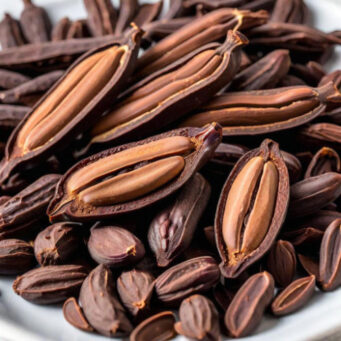The Surprising Health Benefits of Carob Coffee

Contents
In this paper, we’ll discover the wonderful world of carob coffee as a delightful and healthy substitute for traditional coffee. If you’re looking for a caffeine-free, nutritious, and enticing coffee alternative, you’re in the right place. Let’s delve into the nutritional and health benefits of carob coffee, learn how to make it, compare it with regular coffee, find out where to buy it, and wrap up with some insightful conclusions. So, grab your favorite mug and let’s explore the world of carob coffee together!
What is Carob Coffee?
 Carob coffee is a delightful and nutritious alternative to traditional coffee, made from roasted and ground carob pods. With a rich, robust flavor and naturally sweet undertones, carob coffee provides a caffeine-free beverage option. The process of creating carob coffee involves carefully grinding the carob pods into a fine powder and then brewing it to perfection.
Carob coffee is a delightful and nutritious alternative to traditional coffee, made from roasted and ground carob pods. With a rich, robust flavor and naturally sweet undertones, carob coffee provides a caffeine-free beverage option. The process of creating carob coffee involves carefully grinding the carob pods into a fine powder and then brewing it to perfection.
Below are some key points to consider about carob coffee:
- Origin: Carob coffee has been enjoyed for centuries and is derived from the carob tree, native to the Mediterranean region.
- Flavor Profile: The flavor of carob coffee is often described as smooth and chocolatey, with hints of caramel, making it a unique and indulgent beverage.
- Nutritional Value: Carob coffee is naturally rich in fiber, antioxidants, and minerals, providing a wholesome and satisfying drink.
- Sustainability: The cultivation of carob trees is eco-friendly and sustainable, as they require minimal water and no synthetic pesticides.
Nutritional Benefits of Carob Coffee
Carob coffee, derived from the carob pod, is a delightful and nutritious beverage that offers a plethora of health benefits. Here are some key nutritional advantages of incorporating carob coffee into your diet:
- Rich in Fiber: Carob coffee is an excellent source of dietary fiber, promoting healthy digestion and satiety.
- High in Calcium: With a significant calcium content, carob coffee contributes to bone health and strength.
- Abundant in Antioxidants: The presence of antioxidants in carob coffee supports overall health by combating oxidative stress and inflammation in the body.
Furthermore, carob coffee is naturally low in fat and caffeine-free, making it an ideal choice for individuals with specific dietary requirements or those seeking a healthier coffee alternative.
Health Benefits of Carob Coffee
When it comes to health benefits, carob coffee shines as an exceptional choice. It is known to support digestion, promote heart health, and contribute to overall well-being. The absence of caffeine in carob coffee makes it gentle on the stomach, offering a soothing and enjoyable coffee experience without the stimulating effects of caffeine. Additionally, the presence of antioxidants in carob coffee provides further health advantages, making it an ideal option for individuals prioritizing their well-being.
- Mineral-rich: It contains essential minerals such as calcium, potassium, and magnesium, which are vital for bone health, muscle function, and overall well-being.
- Heart-friendly: The polyphenols found in carob coffee contribute to heart health by reducing the risk of cardiovascular diseases and improving blood circulation.
- Calming Effect: Carob coffee’s natural sweetness combined with its lack of caffeine provides a calming and relaxing coffee experience, making it an excellent choice for those seeking a gentle beverage option.
How to Make Carob Coffee
Making carob coffee at home is an enjoyable and fulfilling process that yields a delightful caffeine-free beverage. Follow these simple steps to create a comforting cup of carob coffee:
- Start by selecting high-quality roasted carob pods, ensuring they are free from mold or damage.
- Finely grind the roasted carob pods into a powder using a coffee grinder or food processor. The consistency of the powder greatly impacts the flavor and texture of the final coffee.
- For a single cup of carob coffee, use about 2 tablespoons of ground carob powder.
- Boil water and allow it to cool for a minute before adding it to the carob powder. Use approximately 8 ounces of water for a standard cup of carob coffee.
- Stir the mixture thoroughly, ensuring that the carob powder is well incorporated with the water.
- Let the carob coffee steep for 3-5 minutes to extract its rich aroma and flavor fully. The longer the steeping time, the more robust the flavor will be.
- After steeping, strain the liquid through a fine-mesh sieve to remove any remaining particles and achieve a smooth consistency.
- Pour the strained carob coffee into your favorite mug, and if desired, add sweeteners, milk alternatives, or flavorings to enhance the taste.
- Savor the comforting essence of carob coffee, rich in natural sweetness and free from caffeine, perfect for any time of the day.
Carob Coffee vs. Regular Coffee
When comparing carob coffee with regular coffee, the contrast lies primarily in caffeine content, flavor profile, and health benefits. Let’s delve into the differences and unique qualities of each:
- Caffeine Content: Carob coffee is a caffeine-free alternative, making it suitable for individuals who are sensitive to caffeine or prefer to limit their intake. Regular coffee, on the other hand, contains caffeine, which can provide an energy boost but may also lead to jitters or sleep disturbances in some people.
- Flavor Profile: Carob coffee offers a naturally sweet and mildly roasted flavor, reminiscent of chocolate and caramel. Its smooth and mellow taste appeals to those who enjoy a gentler coffee experience. On the contrary, traditional coffee is known for its intense, robust flavor that varies based on the blend, roast, and brewing method.
- Health Benefits: Carob coffee boasts various health benefits, including being rich in fiber, antioxidants, and minerals such as calcium and potassium. These properties contribute to digestive health, heart health, and overall well-being. Regular coffee also contains antioxidants and may have certain health benefits, but excessive consumption can lead to jitteriness, increased heart rate, and sleep disturbances in some individuals.
In summary, for individuals seeking a gentler, caffeine-free coffee experience with a unique flavor and potential health benefits, carob coffee presents itself as a compelling choice while traditional coffee offers a more energizing but potentially stimulating experience.
Carob Coffee vs. Cacao Coffee
Carob coffee and cacao coffee are two distinct alternatives to traditional coffee, each offering unique flavors and characteristics.
Carob coffee is made from roasted and ground carob pods, which are naturally sweet and have a flavor reminiscent of chocolate. Carob is caffeine-free and often used as a coffee substitute for individuals looking to avoid caffeine or seeking a different taste experience. Carob coffee is known for its smooth, slightly sweet flavor profile, making it a popular choice for those with a sweet tooth or those who prefer milder, less bitter beverages.
On the other hand, cacao coffee, also known as cacao brew or cacao tea, is made from roasted and ground cacao beans, the same beans used to make chocolate. Unlike carob, cacao coffee does contain caffeine, although in smaller amounts compared to traditional coffee. Cacao coffee offers a rich, chocolatey flavor with subtle hints of bitterness, similar to dark chocolate. It provides a natural energy boost from the caffeine content while also offering the potential health benefits associated with cacao, such as antioxidants and mood-enhancing properties.
In summary, carob coffee is a caffeine-free alternative with a sweet, chocolate-like flavor, while cacao coffee contains caffeine and offers a rich, chocolatey taste with potential health benefits.[1] The choice between the two depends on individual preferences for flavor and caffeine content.
Where to Buy Carob Coffee
Carob coffee can be conveniently purchased from a variety of sources, providing coffee enthusiasts with numerous options to explore and enjoy. Here are some places where you can find high-quality carob coffee:
- Specialty Health Food Stores: Many specialty health food stores carry a selection of carob coffee products, catering to health-conscious consumers who appreciate the unique flavor and nutritional benefits of carob.
- Organic Markets: Organic markets often feature organic carob coffee, sourced from sustainable and environmentally friendly producers. These markets are ideal for individuals seeking ethically sourced and high-quality carob coffee.
- Online Retailers: The convenience of online shopping allows coffee enthusiasts to explore and purchase a wide range of carob coffee products from the comfort of their homes. Many online retailers offer diverse options, ensuring that consumers can find their preferred type of carob coffee with ease.
- Coffee Shops and Artisanal Cafes: Exploring local coffee shops and artisanal cafes can lead to the discovery of unique carob coffee offerings. This avenue provides an opportunity for coffee enthusiasts to indulge in the delightful experience of tasting and savoring distinct carob coffee blends curated by passionate coffee artisans.
Conclusion
In conclusion, carob coffee stands out as an exceptional and healthy coffee alternative, offering a delightful caffeine-free experience with a naturally sweet flavor profile. Its nutritional and health benefits, along with its ease of preparation and availability, make it a compelling choice for individuals seeking a fulfilling and nourishing coffee experience. Whether you’re a dedicated coffee enthusiast looking to explore new flavors or someone desiring a nutritious and gentle coffee substitute, carob coffee promises a delightful journey of taste and well-being.
Get Latest Coffee Alt Trends
I'm willing to share my ongoing findings and research about coffee alternatives:
I respect your privacy 100%ABOUT
A personal journey and exploration into the vibrant world of beverages beyond coffee. My name is Ben, and I’m the voice and spirit behind this blog.
Click to read on